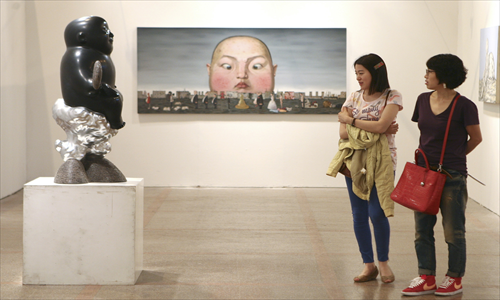Picking art apart
Source:Global Times Published: 2013-10-21 17:53:01

Visitors take in an exhibition of art from China, Japan and South Korea at the Shanghai Exhibition Center in May 2012 that aimed to promote cooperation in art market between the three countries. Photo: CFP
Next month, the 13th Asia Art Festival will be held in Kunming, Yunnan Province.As contemporary Asian art's popularity spreads worldwide, art forums have taken to picking apart the roles globalization, Western influences and curators play in shaping the current art scene.
Lack of Asian consciousness
Organized by the Guangdong Museum of Art and the National Art Museum of China, the Asian Art Curators' Forum held last month gathered 80 curators and museum directors to discuss the "Asian experience" in art.
Following the development of China and other Asian countries, contemporary art and culture in Asia has become a global topic that extends beyond the geographical region.
Biennial, triennial and other kinds of exhibitions about Asian art have been organized with increasing frequency in recent years.
However, problems exist within this growth. Many have noticed that because of globalization, art is losing local characteristics and starting to bear many similarities across borders and hemispheres.
Director of the Guangdong Museum of Art Luo Yiping said during the forum that similarly-themed exhibitions with similar artwork appear in China, Japan and India, and sometimes have an identical appearance to exhibitions in Europe and the US. "The lack of an Asian consciousness is a common problem," said Luo.
Zhang Qing, director of the research and planning department at the National Art Museum of China, also finds that Asian artists have been busy solving domestic issues but now they are beginning to think about the problems they need to face together.
"It is not hard to tell in the exhibitions every year that the Asian consciousness has been neglected," Zhang remarked.
Shifting discourse
Though common problems exist for curators in all Asian countries, different museums have their own issues to focus on.
The assistant director of the National Museum of the Philippines Ana Maria Theresa P. Labrador said their problem is that many pieces of indigenous artwork can't be interpreted from a Western standpoint. Since both art materials and perspectives are localized, only with more detailed, regional research can more in-depth scholarship be accomplished.
For the Museum of Oriental Ceramic in Osaka, Japan, according to curator Kobayashi Hitoshi, what they need to think about is how exhibitions are presented. Porcelains and ceramics as contemporary artwork rather than antiques can make the old museums' way of exhibiting art obsolete.
Though the discussions of Asian art have been an important topic since the first Asia-Pacific Triennial of Contemporary Art held in the 1990s, the specifics of the discussion change from time to time.
For instance, the third Guangzhou Triennial entitled "Say Goodbye to Post-Colonial" suggests an intention of separating Asia from the Western academic system in order to redefine the period.
When it came time for the fourth Triennial, themed "The Unseen," Western art philosophies were back.
The Multitude Art Prize Discourse Series held at the Ullens Center for Contemporary Art in Beijing's 798 Art District early this year was another example of the central discussion taking place on the vast subject of Asian art.
Participants included artists from South Korea, India, the Philippines and many other Asian countries and regions. Related conferences also stated that Asian art would become "a long-term conversation."
"The scale of geopolitical change taking place across Asia can make contemporary art seem powerless to intervene or even participate. As globalization has arguably taken over from where colonialism left off, contemporary art's often complicit relationship with this new cultural and economic order complicates or perhaps compromises its role in society," the introduction says.
Role of the curator
In recent years, many museums and galleries have created Asian departments and invited curators who specialize in Asian projects.
Last year, art critic and curator Wang Chunchen was invited by the Eli and Edythe Broad Art Museum at Michigan State University to be an adjunct curator who is responsible for exhibitions from Asia.
Wang once told the Global Times that a general view was that exhibitions of contemporary Chinese art and Asian art in Western countries were based on Western tastes.
Many Chinese artists have caught on abroad, but few Chinese curators have tasted success overseas.
Now, it is time to see how Asian curators would manage their exhibitions.
Presenting art from many different countries in Asia, bigger questions arise, such as "What is Asia?" and "What is Asian art?"
Is it a geographical definition or does it refer to a certain cultural identity that developed from a long historical transformation?
Indonesian curator Suwarno Wisetrotomo stated that art and artists are related to their surrounding environments. A key element for answering big questions like what Asian art is, he said, is the presentation of the art.
Yet the answers are blurry, said Jay A. Levenson, director of the international program at the Museum of Modern Art in New York, pointing out that all these definitions need time. And no matter how much a new definition of curator may be criticized, the quest to clarify the role is a good start.
The job of curator originally emerged alongside the development of galleries and museums in Europe after the 17th century. It only became an occupation in Asia in the last century, and only the last decade in China.
"In recent years, the number of art investors has grown very fast. The number of art museums, both national and regional, is also increasing, creating bubbles for the art scene," Ji Shaofeng, deputy director of Hubei Museum of Art said during the roundtable discussion.
Taking these lessons to heart while also managing collections is no easy feat.
"A museum is much more than just hanging up all the artwork," Ji added.
Global Times
Posted in: ARTS